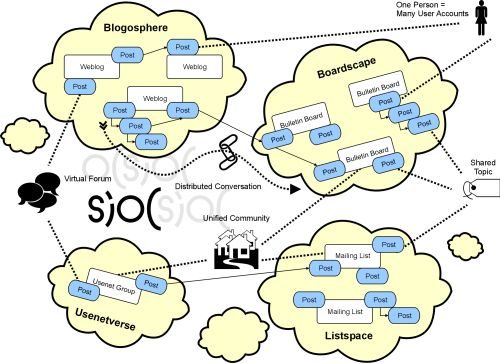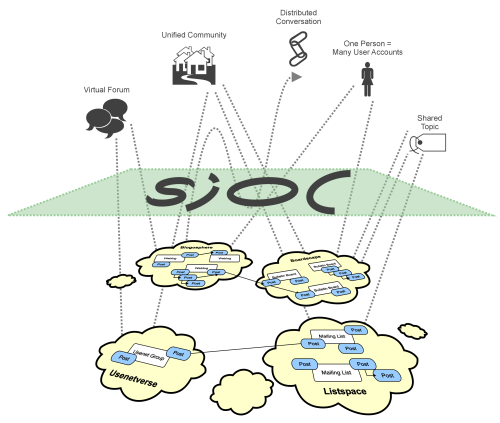Creating Connections Between Discussion Clouds with SIOC
2006, September 13 - 13:13 — Cloud
(Extract from our forthcoming BlogTalk paper about browsers for SIOC.)
SIOC provides a unified vocabulary for content and interaction description: a semantic layer that can co-exist with existing discussion platforms. Using SIOC, various linkages are created between the aforementioned concepts, which allow new methods of accessing this linked data, including:
- Virtual Forums. These may be a gathering of posts or threads which are distributed across discussion platforms, for example, where a user has found posts from a number of blogs that can be associated with a particular category of interest, or an agent identifies relevant posts across a certain timeframe.
- Distributed Conversations. Trackbacks are commonly used to link blog posts to previous posts on a related topic. By creating links in both directions, not only across blogs but across all types of internet discussions, conversations can be followed regardless of what point or URI fragment a browser enters at.
- Unified Communities. Apart from creating a web page with a number of relevant links to the blogs or forums or people involved in a particular community, there is no standard way to define what makes up an online community (apart from grouping the people who are members of that community using FOAF or OPML). SIOC allows one to simply define what objects are constituent parts of a community, or to say to what community an object belongs (using sioc:has_part / part_of): users, groups, forums, blogs, etc.
- Shared Topics. Technorati (a search engine for blogs) and BoardTracker (for bulletin boards) have been leveraging the free-text tags that people associate with their posts for some time now. SIOC allows the definition of such tags (using the subject property), but also enables hierarchial or non-hierarchial topic definition of posts using sioc:topic when a topic is ambiguous or more information on a topic is required. Combining with other Semantic Web vocabularies, tags and topics can be further described using the SKOS organisation system.
- One Person, Many User Accounts. SIOC also aims to help the issue of multiple identities by allowing users to define that they hold other accounts or that their accounts belong to a particular personal identity (via foaf:holdsOnlineAccount or sioc:account_of). Therefore, all the posts or comments made by a particular person using their various associated user accounts across platforms could be identified.
Edit: Here's SIOC acting as middleware.
- Cloud's blog
- Login to post comments


